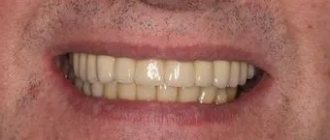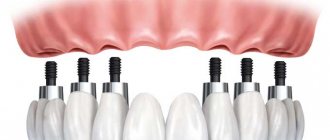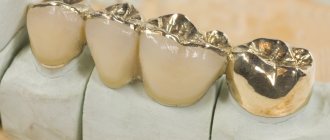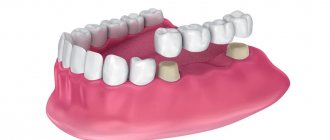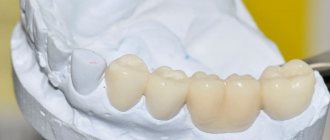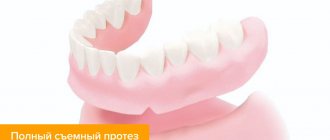Implantation of chewing teeth – upper and lower. Which implant and crown is best for chewing teeth? Which is better, a bridge or an implant? Specialists at the Implantmaster clinic will select the best option for implanting chewing teeth using the latest diagnostic equipment. We use premium implantation systems at affordable prices.
Despite the increased strength of teeth in the chewing area, they are more susceptible than others to carious lesions, inflammatory processes and losses. Moreover, when units are lost in this area, serious aesthetic problems and disturbances in the functioning of the gastrointestinal tract can occur. All of the above negative manifestations are due to the direct participation of teeth in the process of chewing food and, as a result, excessive load. To eliminate such a pathology, it is necessary to urgently contact dentistry to perform implantation.
At the Implantmaster clinic, the process of recreating teeth in the chewing department is carried out by experienced specialists, based on modern protocols, using special surgical templates and innovative digital equipment. This significantly increases the accuracy of the procedures, minimizes pain, shortens the period of implementation and ensures a successful and long-term result.
Next, we will talk in more detail about implantation of chewing teeth , consider the specifics of performing the procedure in the maxillary and mandibular regions, and also introduce you to the pricing policy and existing reviews. We hope that the information received will help you draw the right conclusions about the need to install implants on your chewing teeth, and you will learn to understand its intricacies.
Get a consultation
We will answer all your questions before visiting the clinic!
+7
Online registration
Content
1 What are the consequences of losing teeth in the chewing area?
2 Implantation of chewing teeth on the upper jaw
3 Implants of the lower chewing teeth
4 Which implant is better to place on chewing teeth?
5 Bone grafting for implantation of lateral teeth
6 Which crowns are best fixed to a chewing tooth implant?
7 Methods of implantation of chewing teeth
8 Which is better – a bridge or an implant for chewing teeth?
9 Prices for implantation of chewing teeth
10 Reviews about implantation of chewing teeth
11 Alternative options
Digital diagnostics - to eliminate risks
We carry it out on a high-precision 3D tomograph Sirona Galileos (Germany)
- Determination of the condition of bone tissue, its size to assess the need for bone grafting
- Assessment of the condition of tooth roots during one-stage implantation
- Identification of anatomically important structures (nerves, vessels, maxillary sinuses) to avoid their damage
What are the consequences of losing teeth in the chewing area?
Despite their reliability, molars and premolars are among the most susceptible teeth to pathogenic bacteria. This is due to their active participation in the process of chewing food products. Severe pathologies in the chewing area can provoke tooth loss. This, in turn, can cause such serious problems as deterioration of the anatomical characteristics of the face, disturbances in the functioning of the maxillofacial system, disruptions in the functioning of the gastrointestinal tract and other undesirable changes.
Currently, the most effective method of eliminating the defect is the implantation of chewing teeth. However, the procedure for reproducing molars and premolars differs in its specific features, which we will discuss later.
Contraindications
Relative
the procedure can be carried out with extreme caution
- Unsatisfactory condition of the oral cavity;
- pregnancy;
- period of exacerbation of chronic diseases.
Absolute
the procedure is strictly prohibited
- Blood diseases;
- severe diabetes mellitus;
- immune diseases;
- severe form of tuberculosis;
- osteoporosis;
- endocrine disorders;
- oncological pathologies;
- intolerance to anesthesia drugs;
- serious diseases of the central nervous system.
Implantation of chewing teeth in the upper jaw
It should be noted that the maxillary and mandibular sections have their own unique specific structure. In this case, an important point when losing a tooth in the upper jaw is rapid atrophy. That is, if several years have passed since the loss of such a unit, then a necessary condition for successful fixation of implants will be raising the lower part of the maxillary cavity (performing a sinus lift).
If the tooth is subject to extraction or its loss occurred not so long ago, you can resort to instant methods. During them, the fixation of the prosthetic device is carried out immediately after the insertion of the chewing tooth implant. Due to instant loading, an accelerated period of osseointegration is achieved, equal to 12-16 weeks (3-5 weeks with Straumann implants).
The implant of the upper chewing tooth can also be fixed using the traditional method, which involves step-by-step treatment. However, the load in this case can be carried out only after the end of the engraftment period.
When deciding to install an upper posterior dental implant, you should be aware of the risks associated with this procedure. They are caused, first of all, by the proximity of the maxillary cavities. With an incompetent approach, there is an increased likelihood of injury and the appearance of inflammatory processes.
In our dentistry, consultations are conducted by competent specialists who know all the intricacies of fixation of dental systems in the maxillary region. This guarantees the safety of the manipulations and ensures a prolonged result without complications.
Our team of doctors
Maxillofacial surgeon, Implantologist
Bocharov Maxim Viktorovich
Experience: 11 years
Dental surgeon, Implantologist
Chernov Dmitry Anatolievich
Experience: 29 years
Orthopedist, Neuromuscular dentist
Stepanov Andrey Vasilievich
Experience: 22 years
Endodontist, Therapist
Skalet Yana Alexandrovna
Experience: 22 years
Orthopedic dentist
Tsoi Sergey Konstantinovich
Experience: 19 years
Dentist-orthodontist
Enikeeva Anna Stanislavovna
Experience: 3 years
Implants of the lower chewing teeth
If you require implantation in the lower jaw in the area of chewing teeth, then there is a high probability that this procedure will be carried out using a two-stage method. During the first step, the specialist will perform surgery, after which he will suture the gum tissue. At the second stage, the prosthetic device is fixed, a prerequisite for which is complete engraftment of the dental implant.
It should be noted that if implants of the lower chewing teeth are installed using classical technology, this requires the presence of bone tissue with sufficient density and height. If a CT scan reveals a lack of bone tissue, osteoplasty is an integral part of the implantation. This manipulation involves the transplantation of donor or artificial bone blocks.
The treatment period in this case can be significantly delayed, which is explained by the need to restore bone tissue and achieve the required parameters. But in some situations, the osteoplastic procedure can be performed simultaneously with the introduction of dental structures.
In our dentistry, you can get advice from qualified specialists, which will allow you to determine the need for osteoplastic procedures. In addition, we use the latest oral scanners, which guarantees highly accurate diagnostics and proper planning of further treatment measures.
Stages of treatment
1. Diagnosis and choice of treatment regimen
The doctor performs an examination of the oral cavity and a CT scan to assess the volume and density of the jaw bone. The patient is sent for general clinical tests to exclude possible contraindications.
2. Preparation
Before the operation, the oral cavity is sanitized. The purpose of the procedure is to eliminate pockets of caries, get rid of persistent plaque and tartar, which are a potential source of infection.
3. Implant installation
The operation is performed under local anesthesia. With classic implantation, after installing the implant, a plug is placed and the gum is sutured. If a one-piece implant was used, then the abutment is already included in the structure, it is located above the gum level.
4. Fixation of the abutment
The adapter for attaching the crown is installed only on the classic implant after its engraftment (after 4-6 months). 2 weeks before, a gum former is installed on the artificial root.
5. Installation of the prosthesis
Depending on the protocol, loading of the artificial root with a prosthesis is performed immediately or after osseointegration. With a one-stage protocol, the prostheses are installed on the third day after surgery. In the classic case, after the implant has been implanted.
Which implant is best for chewing teeth?
It is a mistake to believe that doctors use the same type of implants to recreate all teeth. For each individual situation, a different method of prosthetics and implantation system are used, which guarantees the success of the procedure in terms of aesthetic and functional parameters.
First of all, in order to understand which implant is best to place on chewing teeth, you should take into account the anatomical parameters of the jaw structure. Taking into account these features, the doctor selects the size of the implant for the chewing tooth.
If we talk about methods of recreating teeth in the lateral region, most often the traditional method is used here, which involves a step-by-step procedure. In this case, the dental system is initially fixed, and only 12-24 weeks after this, the orthopedic structure is installed. The unique SLActive surface from ]Straumann[/anchor] reduces this period to 3-5 weeks. This is due to the need for high-quality osseointegration of the system with bone tissue. During the healing period, the patient usually wears a temporary prosthetic device.
Almost all modern manufacturers have dental implants in their arsenal, designed to restore teeth in the chewing area. Both premium quality systems and budget models are suitable for this purpose. However, products from the Swiss brand Straumann allow you to get the best aesthetic effect and achieve the necessary functionality. In any case, only a competent specialist in a trusted dental clinic can Which implant is better to place on chewing teeth?”
We offer significant discounts on the installation of top-end implantation systems, which allows you to get an impeccable result with a long guarantee. You can also get competent advice from our doctors regarding which implants are best placed on chewing teeth. Our specialists have impressive experience in restoring the aesthetics and functionality of the side section.
Rating of dental implant manufacturers »
What complications may arise?
- Postoperative bleeding.
- Swelling of the gums.
- Seams coming apart.
- Failure to achieve primary stability of the implant.
- Paresthesia (loss of sensation in the area of implantation)
- Exposure of the implant.
- Peri-implantitis.
- Rejection of the artificial root.
Work examples
How often do you visit the dentist?
Bone grafting for implantation of lateral teeth
It is not possible to fix molar implants in the chewing area if there is a deficiency of bone tissue; an osteoplastic procedure is mandatory. We discussed this point in the previous paragraphs of the article. The process of increasing the size of bone tissue is performed by raising the lower part of the maxillary cavities (in the maxillary region), or by transplanting bone contents (in the maxillary region).
It will not hurt to know that only implantation can stop the process of bone tissue resorption. That is, if the question arises: “ Crown or implant for chewing teeth?”, we can definitely speak in favor of the latter option. As for the removable orthopedic structure, the process of bone loss continues to progress even after its installation.
Read more about bone grafting for dental implants »
If, nevertheless, the patient postponed the start of implantation
And he put it off for a very long time. Returns to the doctor after a few years, for example. What regulations will be followed in this case for implant installation? Here, the moment of implantation also depends on the previous tooth extraction. The dentist must remove the tooth in such a way as not to damage the walls
bone tissue. That is, atraumatic:
You should always try to remove the tooth as carefully as possible. And if the tooth was removed with damage to the bone tissue, and the patient was not implanted immediately, then after two months the question of bone tissue augmentation will arise. What to say if the patient arrived even later? Of course, the question of bone restoration and bone grafting will arise.
How disadvantageous is it for a patient to delay dental implantation?
Research conducted in Russia by independent institutes shows that there is no increase in the number of implantations from year to year, despite the fact that the total number of dental services provided to the population is growing steadily every year. The most popular type of implantation is the implantation of the frontal group of teeth, that is, the front teeth. But in the area of the chewing group of teeth, patients are in no hurry to undergo implantation.
Are there medical reasons for postponing dental implants? Medical reasons for refusing to install a dental implant include general reasons:
(diabetes mellitus, hormonal changes, systemic lupus erythematosus, HIV infection, etc.) and
local
.
For local reasons related to the area of the mouth, at present there is practically no list that existed in Russia 15-20-25 years ago, when this area of dentistry had just begun to develop in the country. At that time, the widespread leadership was held by removable dentures, which had and still have a number of serious disadvantages. Yes, there were many local medical reasons, but progress and technology do not stand still. Therefore, now we can (even conditionally) talk about the general reasons for delayed dental implantation, which I mentioned above.
Removable prosthetics as a deterrent to implantation
Removable prosthetics, which prevents the increase in the number of requests for implantation, should probably be considered from the point of view of the economics of patient costs. Removable dentures are much cheaper than implantation followed by turnkey prosthetics. But removable dentures have a significant drawback - they do not prevent the resorption of bone tissue, and in some cases they increase the rate of resorption, with an increase in the pathological load on the temporomandibular joint (TMJ).
Therefore, in the long term, dental implants have a huge advantage
before removable prosthetics to preserve the patient’s bone tissue and, accordingly, the healthy state of all the patient’s maxillofacial system. As they say, “the miser pays,” but not twice, but several times more during his life with removable dentures.
Which crowns are best fixed to a chewing tooth implant?
The final step, accompanied by the fixation of orthopedic systems, is permanent prosthetics. To understand which crowns are best fixed to a chewing tooth implant , it is necessary to take into account the degree of load on it in the future. As a rule, crowns made of zirconium material or metal-ceramics are preferred in such a situation, due to their increased reliability.
If cost is the deciding factor for you when fixing a molar implant , then a more budget-friendly option for you would be a procedure followed by installation of a metal-ceramic prosthesis.
If it is necessary to achieve an impeccable aesthetic effect, along with increased strength, it is advisable to focus on crowns made of zirconium material or glass ceramics.
As for ceramic dentures, this is not the most suitable material for restoring the lateral zone, since it is not resistant to increased loads.
Read more about the types of implant crowns »
Methods of implantation of chewing teeth
When it comes to the need to reconstruct molars and premolars, the implantation process can be implemented using one of the following methods:
1. Traditional way. Restoration measures are carried out in two steps. Fixation of the prosthetic device or crown is carried out 16-24 weeks after the implantation of the dental structure. This is explained by the need to complete osseointegration and achieve full contact of the structure with bone tissue. During the engraftment stage, it is possible to use a temporary orthopedic structure. It is possible to implement the method in case of bone tissue deficiency with preliminary osteoplasty.
2. One-step method. In this case, loading with a metal-plastic prosthetic device is performed immediately after surgery. In addition, when implementing this method, it is possible to fix dental structures in case of bone tissue deficiency. In this case, the implant is introduced into distant layers of the jaw that are resistant to atrophic processes.
3. One-step procedure. It involves fixing a dental implant immediately after tooth extraction. Moreover, simultaneous installation of a prosthetic device made of metal-plastic is allowed. In some situations, a specialist can fix a classic type implant, on which a permanent crown is installed after the end of the osseointegration period.
As for the use of implantation technology, it is selected in accordance with the clinical situation:
- If one tooth is missing, a traditional two-step procedure is usually used. A prerequisite is the passage of an engraftment period, after which the load is carried out with a prosthetic device. In order to eliminate the aesthetic defect during the period of osseointegration, it is possible to use removable orthopedic structures;
- In case of multiple deficiencies, the priority option is to carry out a one-stage procedure with simultaneous fixation of an adaptation-type prosthesis.
Requirements for implants and crowns
There are high demands on materials for restoring molars and premolars. These areas bear the chewing load. Dentists do not use implants that are too thin and short. Our specialists use:
- Classic implants
- Compression implants
- Basal implants
The product line includes models for all clinical cases. Prostheses for replacing several teeth in a row - with a titanium arch that splints the implants and prevents them from loosening under load.
When installing several implants in one clinical case, all metal components of the structure are made of the same material. Impurity metals of various grades of titanium do not combine in the acidic environment of the oral cavity, causing allergies, galvanic syndrome, and rejection of the structure.
The surface of ROOTT premium implants does not contain foreign impurities. All metal products are made from the same grade of medical titanium, which eliminates galvanic syndrome.
What is better – a bridge or an implant for chewing teeth?
When several teeth are lost in the chewing area, the patient is faced with a difficult choice : to fix a bridge or an implant on the chewing tooth. Of course, the preferred choice would be the introduction of a dental implant, followed by the installation of a transition element and a prosthetic device. But such a technique cannot always be implemented, since it requires significant costs - in the absence of sufficient bone tissue.
An alternative option in such situations is the fixation of a bridge-like orthopedic structure involving the patient’s own teeth. The negative aspects of this procedure include the need for significant preparation of supporting units and increased pressure on them, which in the future can provoke serious degenerative processes.
Endosseous or intraosseous implantation
This technique has proven itself to be reliable, safe and effective.
An implant, that is, a metal pin, is implanted into the bone instead of a real root, and a crown made of the selected material is installed on the upper protruding part of the structure.
Prosthetics can occur in one or two stages, but invariably demonstrates excellent results:
- high primary stability;
- maximum percentage of engraftment;
- uniform distribution of chewing load;
- long service life;
- high level of patient comfort.
This is an advanced method of dental implantation, the types and methods of which allow you to restore any number of dental units, even with complete edentia. Suitable for prosthetics on the upper, lower jaw or both at once.
During the intraosseous implantation procedure, root-shaped implants are used; in some cases, for example, with bone tissue defects, plate systems or combined structures are installed.
Prices for implantation of chewing teeth
| Implant Straumann SLA (Switzerland) | -15% 50 000 42 500 ₽ |
| Implant Straumann SLActive (Switzerland) | -15% 55 000 46 750 ₽ |
| Implant Astra tech (Sweden) | -15% 55 000 46 750 ₽ |
| Implant Nobel Biocare (Sweden) | -15% 55 000 46 750 ₽ |
| Anthogyr implant (France) | -15% 40 000 34 000 ₽ |
| Dentium implant (South Korea) | -15% 35 000 29 750 ₽ |
INSTALLING THE GINGIVAL FORMER
| -100% 5 000 0 ₽ |
| Complete list of prices for dental implants » |
Prices for dental implantation on a turnkey basis »
To accurately determine how much a molar implant fixed in the chewing area costs, you need to take into account a number of points.
First of all, the price of services depends on the number of dental units involved and the rating of their manufacturer. In addition, the cost of osteoplastic procedures may be included in the total costs.
A separate cost item is the installation of permanent prosthetic devices. In this case, the material used in the production of crowns and the type of structure play a decisive role. Also, the cost of the procedures may include related medical procedures, including professional cleaning and treatment of teeth with carious lesions.
Reviews about implantation of chewing teeth
In general, people leave many positive comments about posterior restoration. Negative opinions are mainly associated with an unprofessional approach to treatment and a low level of competence of specialists.
Therefore, if you dream of getting an ideal result when fixing dental structures in the chewing area, it is better to deal with trusted dentists and qualified doctors. In this case, you should pay attention to the technical equipment of the clinic and the degree of trust in it from patients who have already undergone treatment there.
Alternative options
If there is a lack of teeth in the chewing region, an alternative treatment option may be the installation of removable orthopedic structures. However, it is not always possible to fix a bridge-type prosthetic device. Sometimes the patient only has supporting units on one side of the defect, which explains the need to use a removable prosthetic system that is fixed to these teeth and gums.
Removable prosthesis. This is a fairly low-cost system that is accessible to the vast majority of patients. However, along with the effectiveness of this design, there are some negative aspects associated with its operation:
- Uncomfortable to wear. Due to the presence of a massive acrylic base, the prosthetic device can cause irritation of the gum tissue;
- Insufficiently strong fixation. Many patients resort to the use of additional gels, ointments and adhesives;
- Light load. Due to the lack of necessary pressure on the bone, it undergoes further resorption. Over time, this deteriorates the strength of the prosthetic device and leads to the need for its relocation.
Taking into account the above disadvantages, we can judge the advisability of installing dental implants instead of removable prosthetic devices using one’s own teeth as supports.
